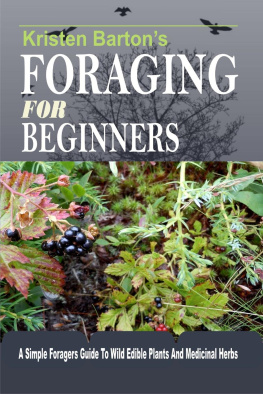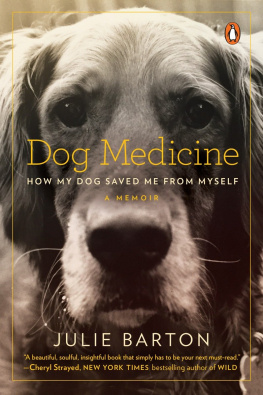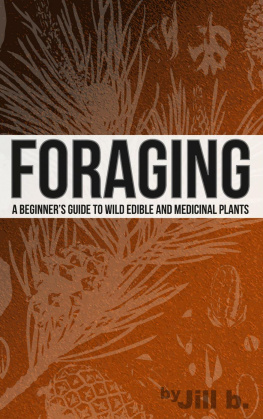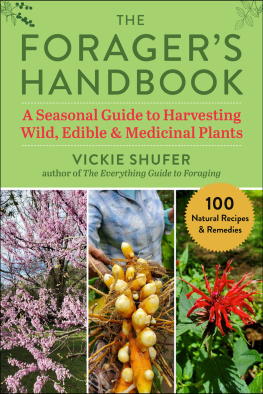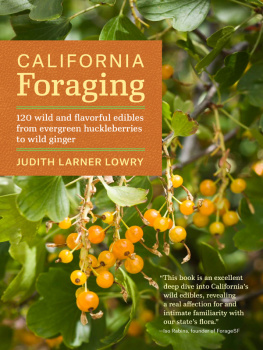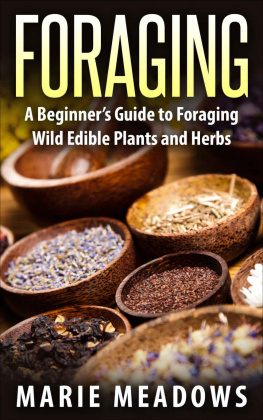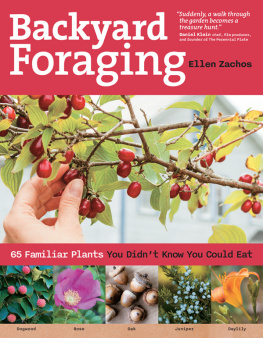Foraging For Beginners
A Simple Foragers Guide To Wild Edible Plants And Medicinal Herbs
Kristen Barton
Copyright 2015 Kristen Barton
All rights reserved. No part of this publication may be reproduced, distributed, or transmitted in any form or by any means, including photocopying, recording, or other electronic or mechanical methods, without the prior written permission of the publisher, except in the case of brief quotations embodied in critical reviews and certain other noncommercial uses permitted by copyright law.
Disclaimer
The information in this book is solely for informational purposes, not as a medical instruction to replace the advice of your physician or as a replacement for any treatment prescribed by your physician. The author and publisher do not take responsibility for any possible consequences from any treatment, procedure, exercise, dietary modification, action or application of medication which results from reading or following the information contained in this book.
If you are ill or suspect that you have a medical problem, we strongly encourage you to consult your medical, health, or other competent professional before adopting any of the suggestions in this book or drawing inferences from it.
This book and the authors opinions are solely for informational and educational purposes. The author specifically disclaims all responsibility for any liability, loss, or risk, personal or otherwise which is incurred as a consequence, directly or indirectly, of the use and application of any of the contents of this book.
TABLE OF CONTENTS
Other Books By Kristen Barton:

Delicious Homemade Jerky Recipes: 43 Jerky Recipes For Easy Meal Times - Beef Jerky, Chicken Jerky, Turkey Jerky, Fish Jerky, Venison Jerky And More

Sushi Cookbook For Beginners: A Simple Guide To Making Sushi At Home With Over 70 Delicious Sushi Recipes
INTRODUCTION
T his beginners' guide contains pictures and descriptions of 39 species of edible wild plants that can be found in the urban environment. The aim is to provide beginner foragers with a pocket guide to plants they can easily find around them. Many species were not included because they require complex and more cautious preparation.
The plants in this book will be more than sufficient for your foraging adventures. Dandelions, chickweed, thistles and nettles are available in abundance and they can provide all the nourishment you need if you ever find yourself in a situation where you have to live on foraged food. However, learning about the other plants will provide you with some variety and make foraging more interesting.
Wild edible plants exist almost everywhere and most of the most common ones are not too far from you. Once you start foraging, you will discover an abundance of food you never knew existed. Edible weeds, herbs and fruits have been foraged and eaten or used for medicine for thousands of years. They possess all the vitamins, minerals and vital nutrients that the human body needs for healthy living.
You don't have to go too far to start foraging. Some of these wild edibles are likely to exist in your backyard, in fields and places you walk every day. There is a wild range of wild edibles you can eat as long as you have properly identified them to be safe for food. You may simply start foraging some of these plants to add to your daily food.
Foraging is not only about surviving on wild plants. There are also other benefits of eating wild edibles. They will reduce your grocery expenses. They are strong genetically and more nutritious than hybrid store produce. Your immune system will get a boosts from the medicinal properties of these plants. Foraging is also a good way to get some exercise, spend time in nature and get some vitamin D from the sun!
The more you harvest wild edible plants, the better you'll become at foraging. Each time you go out, try to practice identifying a new plant. Study its edible parts and how to use it for medicine. As you keep doing this, the more comfortable you will become with foraging.
Happy foraging!
Kristen Barton
Basic Laws Of Foraging
B efore going out to forage in your location, it is important to know that you are on the side of the law. The rules for foraging for mushrooms, greens, berries, roots, seaweeds, shellfish and fish on public lands are generally similar but notable differences exist in different locations. Even if you are familiar with state and federal laws, it is vital to be sure of the rules of small jurisdictions such as counties, municipalities, townships or district lands. Generally:
- Do not harvest on public lands where prohibited.
- Do not trespass. Obtain permission for harvesting on private lands.
- Do not disturb or harvest protected wild plants.
- Where you dont have information or the provided information is insufficient, endeavor to call or write the regulatory office of the land manager.
Ethics Of Foraging
A void Over Harvesting There is a limitation to every population even where there is a large colony of edible wild plants. Limit your collection to just what you need and leave enough for repopulation. Ideally, do not collect more than 10-25 percent.
Do Not Harvest Protected Species Obtain information about the wild plants that are protected in your location. Furthermore, some plants that seem abundant in your locality may be endangered in other locations.
Collect Only Needed Parts You dont have to uproot a plant if you only need the foliage, flowers and fruits. In places where there are only a few occurrences of a wild plant, take a little from each plant and leave enough foliage for them to continue growing.
Respect The Environment Wherever you are collecting, do your best not to disturb the environment. Also try not to disturb wild life, especially in the breeding season.
Foraging Safety
H arvest Only From safe Stocks Check for sources of contamination in the environment. Dont pick plants that are growing in polluted areas. Avoid wild plants near busy roadsides or landfills. Exhausts from vehicles contain heavy metals such as lead and these can be absorbed by plants.
Avoid Areas That Have Recently Been Sprayed With Pesticides Chemical deposits are usually visible on leaves and some will be wilting.
Be Sure Of The Water Source This is very vital if you plan to eat the plant raw. There are also chemical pollutants that cannot be removed by cooking. Sources of contaminated water include effluent seepage and water runoff.
Harvest Only Healthy Plants When you harvest healthy plants, the risk of illness is greatly minimized and you will also get more nutritious food. Telltale signs include discoloration, or mildew, fungus and wilting. Do not eat anything that is starting to spoil.
Eat Only Properly Identified Plants Make sure you have correctly identified the plants and confirmed that it is safe for consumption. Some parts of particular plants may not be edible.
Wash All Plants Before Using A thorough washing is essential to get rid of dirt and external contamination.
Proper Identification
I t is very crucial to avoid accidental poisoning when getting food from the wild. Eat only plants that you have identified positively to be safe for food. Many people have lost their lives because they mistook poison hemlock for wild parsnips or wild carrots.
Next page
